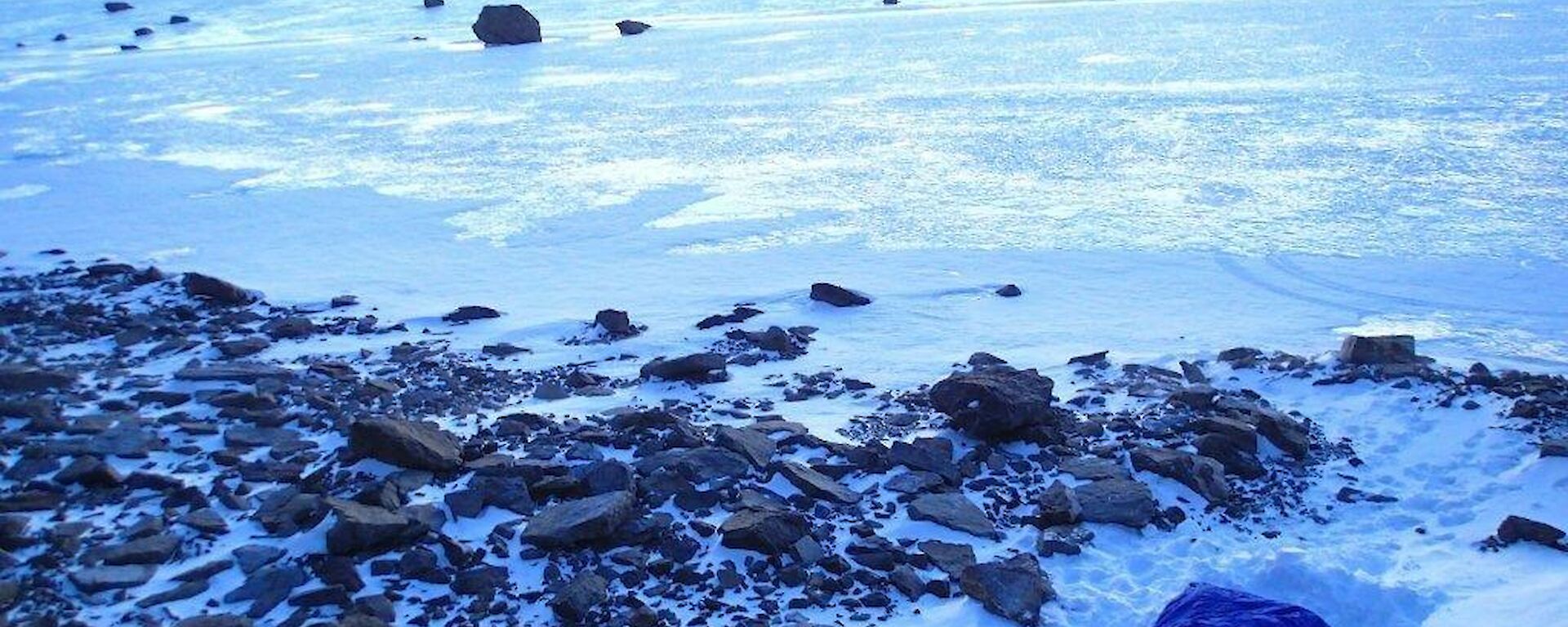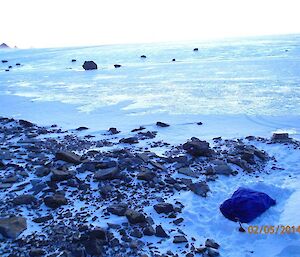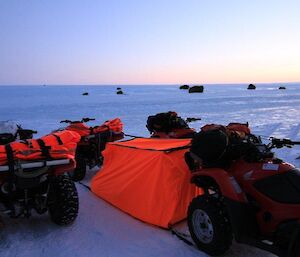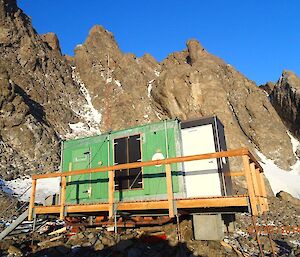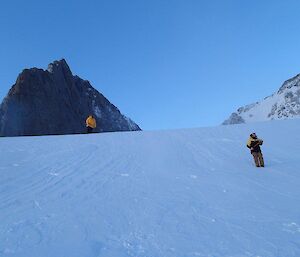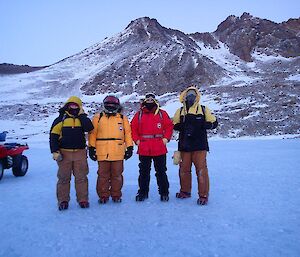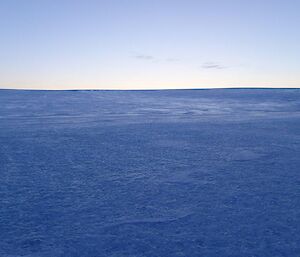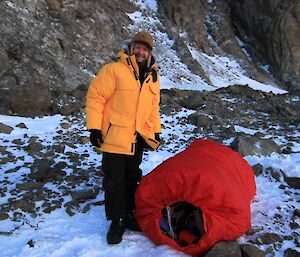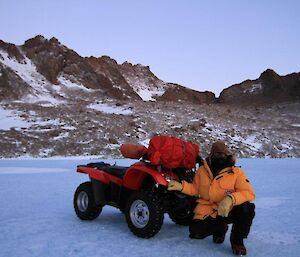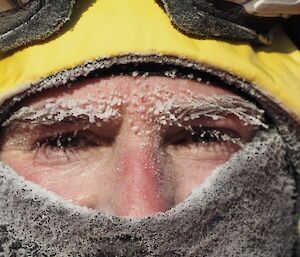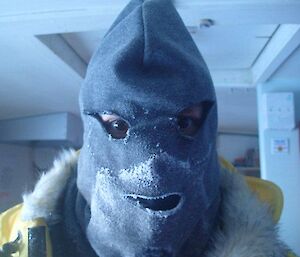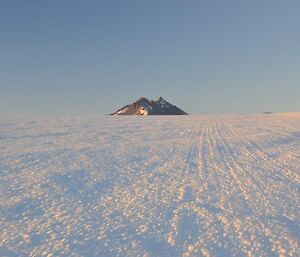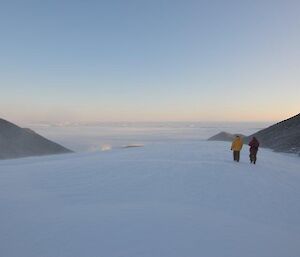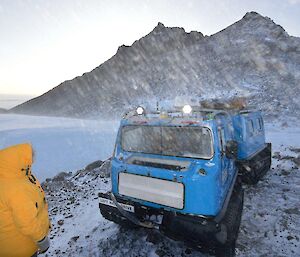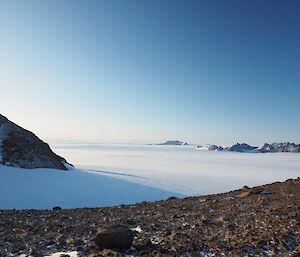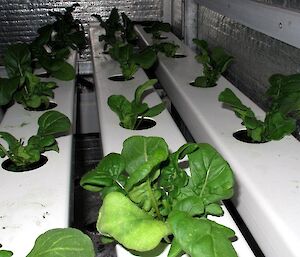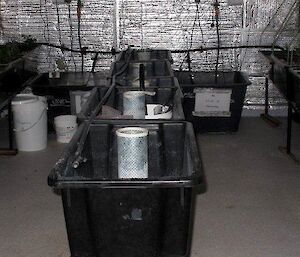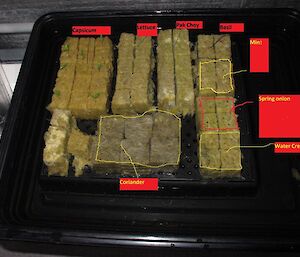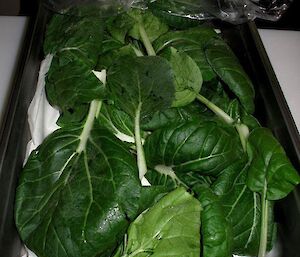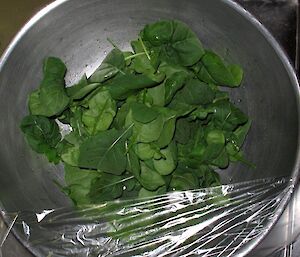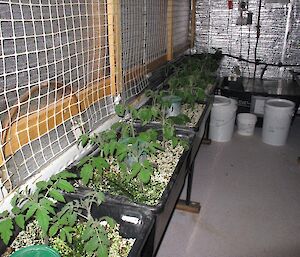Being the Station Leader of an Antarctic research station is a privileged position for several reasons. To be afforded the responsibility of managing a group of people in one of the planet’s harshest environments with little to no support in times of complete darkness and through weather so harsh and brutal that only the brave dare to experience, is something special.
Then there is the weekly station news!
As station leader, I am ‘Editor in Chief’ of Mawson’s news and everything in between so when it comes to writing stories, uploading excerpts and photos I have the final and irrefutable say. That is, if my Antarctic family do not agree with my version of events I don’t post their interpretation. Simple.
So here goes my version of events as experienced by me, and as sure to be admired by Antarctic explorers past and present.
Field training — North Masson Range and David Range
It was a chilly Friday morn’ when Heidi, Dan, Matt, Craig and I made the brisk walk across to operations for a lesson in navigation. It was clear from the outset that navigation was not part of the screening at the tradies selection centre. If we were to make Rumdoodle hut by nightfall I would need to step up and take map and compass in hand and lead the way.
It took some hours but the gang eventually found their way back to the red shed for smoko – I suspect they just followed their noses. Shortly afterwards we took to the EVS (emergency vehicle shelter) where we checked our quad bikes before we tied, fixed and attached our gear to the racks front and rear of the quads. I placed my survival pack on the front rack and wrapped the rope around every bar and poked it through every nook and cranny hoping my theory of knot tying — don’t know knots, tie lots — will see my worldly possessions for the next three days not succumb to the Katabatics and end up somewhere out in Kista Straight! Not long afterwards we donned our 15 layers of thermals, fleece, Carhartt’s and Canada Goose and set off toward the plateau.
Heidi asked if I would mind being ‘Tail-end Charlie’, that is the last rider in the convoy. Of course I said yes. Whilst Heidi didn’t say it (I suspect she was conscious of not upsetting the other boys), she chose me because I am the better rider. From here I could keep an eye on the rest of the gang and ensure they didn’t get too far off track, given they are navigationally challenged.
As we cruised up and onto the plateau the Katabatics came out to greet us. They were blowing hard and fierce, and directly at us. It was here that the guys truly appreciated Heidi’s decision as I’m sure they found some comfort in the thought that should they get blown from their quad bike, I was there to catch them as they blew past.
We endured the Katabatics for an hour before riding into the ‘lee of the North Masson Range and calmer waters. From here we cruised up to Rumdoodle hut and parked the quads on the ice edge.
At Rumdoodle
Dan, Matt, Craig and I were to spend the night in a bivvy bag whilst Heidi was to enjoy the comforts of the hut. Heidi gave us a brief on selecting an appropriate bivvy site, which included tips and tricks, and what to look for and suggested we all bivvy down together. Then the four of us walked off in separate directions to find our own piece of Antarctic privacy. It’s a bloke thing!
I chose the most ‘hardcore’ site, having to dig down into the snow and ice to fashion some protection from the winds whilst the other lads struggled to find their way back to the quads to retrieve their gear.
It was then time for dinner. With the hut sweltering at +30°C Heidi made us cook outside. The other lads were struggling to grasp Heidi’s intent and stood staring at the hut whilst I cooked dinner for everyone.
They eventually wore her down and she relented and allowed them to eat dinner in the warmth of the hut. I was not comfortable with this. I was torn between those heroic explorers of the past and my team. I stood there for a few moments pondering my choices. I could stay outside in the freezing elements as my forefathers had done or I could join my team inside the hut. The torment was near unbearable. It wasn’t until they all stood on the weathered and battered porch and called me to join them that I made up my mind. I looked at their cold, tired and scared little faces and realised they really needed me. So as a true leader I put the team’s needs before my own and joined them inside the hut. As I sat and peeled the layers off I reflected on the sacrifices a leader must make when my toes came back to life for the first time since leaving station four hours earlier.
After dinner we sat and chatted and I told stories and they hung off every word I said before us boys headed out to bivvies and Heidi tucked into her warm sleeping bag.
Bivvy up
For those who don’t know what a bivvy bag is, it is basically an oversized sock! It is windproof and waterproof and large enough to fit you and all your gear including your survival pack inside. What they are not is warm. As you breathe your breath condenses and freezes on the inside of the bag and you end up with a layer of ice an inch thick. Well almost. Then the winds blow or you roll over and brush the roof and the ice comes tumbling down, showering you in your own carbon dioxide laden icicles.
As we stepped out of the hut and into the cold Antarctic air we were in awe at the sight before us. The Antarctic sky was out and it was spectacular. Normally in times of a new moon (well new-ish) you would expect complete darkness with perhaps a bit of light from the odd star here and there but this was different, very different. The night sky was alive and the stars shone down and across the plateau, their reflections dancing across the ice. On our right and beyond the shadowy silhouette of the North Masson Range, there was light. “It must be the lights of Davis off in the distance” said one of the boys. “Not quite”, I politely replied. (Station leaders are always polite — and humble). The light was real. It was intense and it was just over the horizon. And it was all natural! Nothing man-made here, just the constellations at their brightest. Anyone who has ever stood on the concourse of the MCG on a chilly Melbourne Friday night (to see Geelong conquer yet another opponent) and peered up at the mass of dark, cold concrete to see the light emanating out from the open roof top, well that was what it was like. The light was so brilliantly intense. We stood there for several minutes and not a word was spoken. That was until I said something inspirational that stirred the lads to move on.
We walked up and down the ice gazing upward until we had returned to our bivvies. Here we all stared upward again so as to capture one last image and freeze it into our minds before reluctantly climbing into our bivvy bags.
I survived the night and quite surprisingly managed to get a few hours of good sleep. I recall stories of those who have bivvied before rejoicing in the fact that they didn’t have to get up during the night for ‘twinkles’. Well I was less fortunate and twice nature called. That is the last time I listen to Heidi who insisted we remain hydrated. It wasn’t all bad though. With delicate hands and moves that would make any circus contortionist proud I managed to get the business done without getting out of my sleeping bag, only to repeat the process again an hour later.
Navigation
The morning came and into the hut for breakfast where we told stories of our heroic night out in the Antarctic elements. After a cuppa or three it was onto the day’s training. We set off for a nearby slope to practice ice travel. We walked up, down and across the slope using our micro spikes (little mini crampon thingies that attach to the sole of your boots) before using the ice axe to cut steps into the slope. It was then onto self-arresting. Heidi showed us how to throw ourselves down the slope and use the ice axe to slow our descent until we came to a stop. I felt like an eight year old running around jumping in all the puddles. It was a lot of fun.
Afterwards we returned to Rumdoodle for another cuppa before those dreaded words! “Ok, get your maps out, it’s time for some nav”, says Heidi. “OMG”, I thought. Here we go again! It turned out to be not as bad as our first lesson on Friday. This is probably because I stepped up to help Heidi out when even she, the FTO, couldn't get through to my tradie friends.
With our route chosen and compass in hand we set off for way point R-06. To my surprise we made it. We then set about navigating our way around to Fearn Lake where we parked our quads and walked around taking in the sights. Fearn Lake is nestled beneath a quiet, calm and somewhat soothing saddle between South Doodle Peak and Mount Ward. I stood and watched the snow petrels in wonderment of how they manage to survive out here in these harsh conditions. Soon afterwards we returned to Rumdoodle hut.
A night on the quad
Now it was crunch time. Earlier that day I made mention that I might sleep the night in a new quad bivvy. Why did I say this? I don’t actually know! Perhaps I was excited at being up on the plateau or having taken on the Antarctic elements and survived a night in a bivvy bag, but whatever the reason in the eyes of my team I made a commitment and they were determined to make me keep it. I could have easily said that I was only joking and moved into the vacant top bunk but, well, only other blokes will understand that that was never an option. I opened my big mouth and it was into a quad bivvy for me. Heidi and Dan helped me set it up and I think they actually enjoyed it — enjoyed the thought of me sleeping on the ice as they nibble on biscuits and cheese, and enjoyed wine whilst they rubbed their red hot little toes by the generator-fired electric heater! Anyway, there was no use in pondering what might have been. I threw my survival bag into the quad bivvy and climbed on in.
It was a considerably more comfortable night than the usual bivvy. There was a lot more room to move and roll around, and despite the fluorescent orange colour of the quad bivvy, I managed to get a good night’s sleep, listening to the ice creak and crack all night as she stretched her legs. And no, I didn’t have to ‘twinkle'. By sunrise I had survived another night in Antarctica, which will only add to my legendary, hardcore manliness status back on station.
Fang-tasia
After another warm breakfast it was time to refuel the quads and clean the hut — “Why?!”, I asked, “I haven’t slept in it!” Before too long we were ready for the road. We programmed our GPS’ for Fang hut and it was Matt to lead us off. Fang hut is positioned in a sheltered saddle in the David Range approximately 12 kms from Rumdoodle hut. Again I was ‘Tail-end Charlie’ — by now I was getting used to carrying these guys. At some point on the Rumdoodle — Fang traverse, Matt decided it would be a good idea to not cross a frozen melt stream at 90 degrees but rather ride parallel to it and drop his two left wheels in and see how far he could get. He didn’t get very far! We were all off the bikes and heaving Matt’s bike out of the melt stream only for him to do it again immediately after! Honestly, Matt?
The Katabatics were out in force again as we traversed toward Fang hut. Many of us have trouble on the quads with our visors fogging up. I have tried many different options and combinations of masks, balaclavas and everything in between but I have not yet found a system that works for me. By the time we reached Fang hut, my balaclava was stuck to my face — frozen solid! This was caused by my breath condensing and then freezing the balaclava onto my cheeks and nose. Frost-nip had set in. Frost-nip is the freezing of the epidermis.
The epidermis is composed of the outermost layers of the skin. It forms a protective barrier over the body’s surface, responsible for keeping water in the body and preventing pathogens from entering, and is a stratified squamous epithelium, composed of proliferating basal and differentiated suprabasal keratinocytes. The epidermis also helps the skin regulate body temperature. Keratinocytes are major cells.
Not even Doc James’ job is safe when I’m on the continent!
I grit my teeth and despite the burning and inexorable pain — of which a lesser man would have required a medivac — I pushed on. Just an Antarctic scar to show for my efforts I thought. All good things come at a price.
Once at Fang hut, the guys and Heidi stepped inside to warm up. I didn’t really need to go into the hut as I've spent two nights sleeping out in the elements and had become accustomed to the pain and discomfort of frozen digits! I did not however wish to flaunt my manliness and intimidate my fellow adventurers so as I have done so often before, I took one for the team and stepped inside.
After warming up we took off on foot climbing to a saddle that rests between Fang Peak and Mount Parsons. We sat there, nestled from the wind and basking in the midday sun. I recall a feeling of vast nothingness, nothing but empty space. Rarely have I ever felt as content as I did right then. It was perfect. I didn’t want to leave. Just like the stars on the first night, I was desperate to hold on to this image, hold on to this feeling and I tried so desperately to burn the experience to memory. The smell, every breath of wind and every ray of sunlight as it rest upon my frozen face. It was all perfect. Alas, my moment in the sun was interrupted with the sound of movement and we were soon on our way back to Fang.
Leading the way home
Finally, it was my turn to lead the convoy. It was time to show these guys how to ride out front. With GPS’ programmed for Mawson we set off in the fading sunlight. It is a two hour traverse back to station from Fang hut so Matt had strict instructions to avoid melt streams, Dan was told to harden up and stop thinking of his frozen fingers — “You’ll eventually get the feeling back” Heidi said, and Curly was told to, well, just hang on! Heidi took on ‘Tail-end Charlie’ duties and we were off.
We rolled out from Fang and paused momentarily before driving out and into the raging Katabatics. At times we were travelling at 25km/hr and the blowing snow was racing past us as if we were standing still. At other times we were reduced to 10km/hr as visibility was bleak, and we were forced to dodge the sastrugi and mountains of blown snow that somehow manage to accumulate on the ice even when the wind is blowing at 40 knots (72km/hr). It was a pure and masterful display of navigation that found us at the first cane pole. (Well done Steve!) The navigation continued until I could no longer see my GPS. It kept sliding onto its side and into a position where I could no longer see the screen. At first I thought it was just tired and needed a rest but then Heidi tightened my map case, which was strapped across my survival pack and sitting on the front rack of the quad bike. Off again. After a while Heidi asked me to stop leading and return to the role of 'Tail-end Charlie'. She didn’t say it but I reckon she was looking out for Matt, Dan and Craig’s self esteem. I get that a lot. So without question I returned to the back of the convoy.
Soon afterwards, we returned to station, greeted by a rapturous reception. I was overwhelmed. They really missed me.
Clearly I am being a little silly. It was a great trip and a real adventure. My silliness aside it was with true ‘Antarctic community spirit’ that we all chipped in, enjoying a joke and a laugh and some amazing sights — and the lads weren’t really that bad at nav! Thank you, guys.
Steve Robertson, Station Leader

